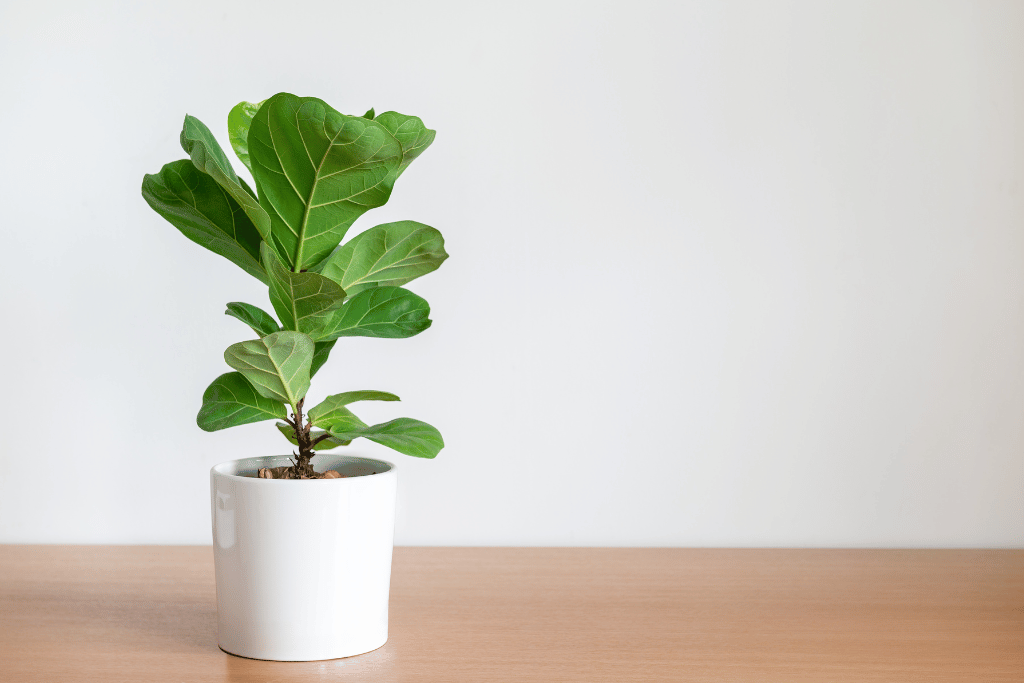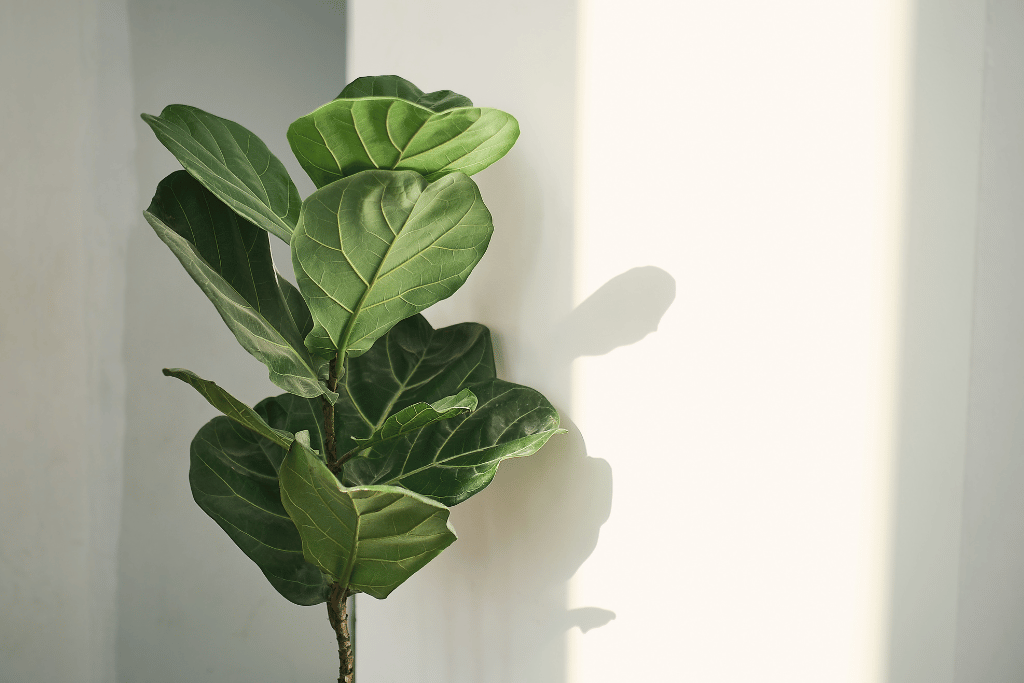
Famous for their large and pretty leaves, fiddle leaf figs are quite a popular houseplant that many people use to decorate their homes, adding some character to interior spaces. Though fiddle leaf figs can be a bit finicky at times, you may find that their leaves will occasionally droop – which is concerning to see. If you’re wondering, ‘why is my fiddle leaf fig drooping?’ There are several different reasons why it could be happening.
Native to West Africa, fiddle-leaf figs are broadleaf evergreens typically grown indoors in unsuitable climates. They’re able to grow over 15 meters tall in their natural habitat and around 3 meters indoors. Their leaves can grow to approximately 30 inches in length, making them a popular plant due to their massive leaves!
So, let’s explore some reasons as to why your fiddle leaf fig’s leaves might start drooping. Take note that they are native to West Africa, so many of the problems may be because the place you are keeping it in may not have similar enough conditions, such as humidity or water.

Why Is My Fiddle Leaf Fig Drooping?
1. Overwatering
As fiddle leaf figs are native to tropical rainforests, overwatering can be a prevalent problem for them when kept as a houseplant. In these rainforests, they typically grow in well-draining soil, which means that any excess water is drained away quite quickly. In contrast, figs kept in pots in our homes might not have sufficient drainage to do this and might instead be left in stagnant water for a while.
To counter this, you need to make sure that your pot has adequate drainage for the fig. You should also make sure that you’re not watering too often. I like to stick my finger an inch deep into the soil to check its moisture – if it’s still soggy, I’ll hold off on watering until it dries out slightly. Overwatering can promote root rot, which can, in turn, kill the entire plant, so it’s essential that we avoid this and notice any signs of overwaterin2g.
2. Underwatering
While overwatering may be an important problem to look out for with fiddle leaf figs, underwatering is also a problem that should be addressed. When we don’t give our plants enough water, their leaves will likely start to droop. You should be watering your fiddle leaf fig regularly, especially during the growing season when the water demand will be higher. It would be best if you never let the soil completely dry out; otherwise, this can kill the plant very quickly.
It’s essential not to stick to a strict schedule when watering your plants; instead, you should be checking the moisture of the soil before you water. This will help prevent both overwatering and underwatering.
Lack of Light
With a good amount of light, your fiddle leaf fig will grow well. Bright and indirect light is the best type of light for figs, and if they aren’t getting enough light, it’s likely that the leaves may droop and turn yellow or brown. It’s important that they aren’t kept in direct sunlight; otherwise, the leaves may become sunburnt, and they may fall off.

If you find yourself not getting enough light in your home, you can keep your fiddle leaf figs under an artificial grow light, which should help your figs get enough light.
Temperature
No one likes being too cold, and neither do our plants—fiddle leaf figs like to be on the warmer side, keeping around 15-24C (60-75F). When temperatures drop below 10C (50F) or go above 29C (85F), you’ll find that your fig may start to droop and put out some worrying signs like yellowing.
Fiddle leaf figs should be kept in an environment where the temperatures stay stable, not being affected drastically by things such as the opening of a large window, door or air conditioning unit.
Pests and Disease
Unfortunately, fiddle leaf figs can be pretty susceptible to pests and diseases – particularly mealybugs, root rot and spider mites. If your fiddle leaf fig is drooping and you’ve gone through the other reasons (and they don’t seem likely), then it might be wise to check for any pests or diseases. Disease infection can manifest as yellow or brown spots on leaves or sticky residue from aphids (likely honeydew).

You should be checking your plants regularly for any signs of pests or diseases and make sure to take the appropriate and correct steps to prevent the spread of them. For treating pests, I’ve found it’s best to use neem oil. Neem oil is organic and won’t harm the environment, and it’s very effective at treating pests. You can find it for relatively cheap online or at nurseries, but I prefer to buy it online.
Final Thoughts
If your fiddle leaf fig is drooping, it’s likely to be due to one of the factors I’ve listed above – or if you’re really unlucky, it might be a combination of these. Stress is terrible for plants and can slow their growth or even lead to their complete death. It may also promote pests and diseases infecting your plant, so it’s important that we keep our plants happy and healthy. Understanding what can stress particular plants is the best way of keeping them alive – it helps us avoid doing anything wrong.
Frequently Asked Questions (FAQ)
What does an underwatered fiddle leaf fig look like?
Some common symptoms of underwatering on fiddle leaf figs (or any plant in general) are the browning of the leaves, curling inwards and leaf drop. Browning and curling are usually the early stages of underwatering, while leaf drop seems to occur when left untreated. Dropping leaves reduces transpiration for the plant, showing you that it’s stressed and needs more water. It’s best to give your plant a thorough watering if you notice this, making sure that you don’t water it every day from that point; otherwise, you’ll end up overwatering it too.
How often should you water a fiddle leaf fig?
I don’t advise sticking to a schedule, but I’ve found that fiddle leaf figs typically require watering about once per week. This will depend on the location you give it, such as the amount and intensity of light it’s receiving, combined with the temperature and general health of the fig. In winter, the water demand of your fiddle leaf fig will be reduced, so make sure that you adjust your watering according to this.
Should fiddle leaf be misted?
Ideally, fiddle leaf figs should be kept at 30-65% humidity. If you find that it’s very dry in the room you are keeping it in or any position you have it in outside, then it might be worth misting it or investing in a humidifier. The majority of houseplants love humidity, and it helps them to grow a lot faster and promotes their general health.
Can I water my fiddle leaf with tap water?
Yes, fiddle leaf figs are safe to water with tap water. Some other plants can be sensitive to the chemicals in tap water, like Dracaenas, which are sensitive to fluoride. Fiddle leaf figs are able to tolerate minerals and other ingredients in tap water, so there’s no need only to use rainwater or do any extra steps to the tap water before using it for your fiddle leaf fig.



